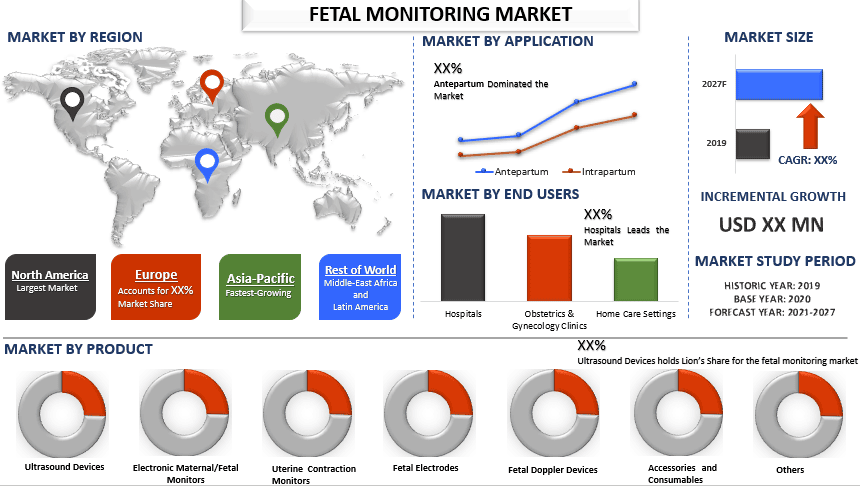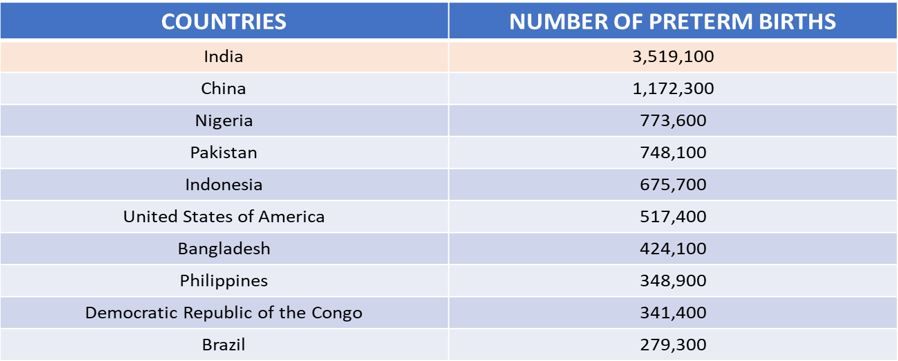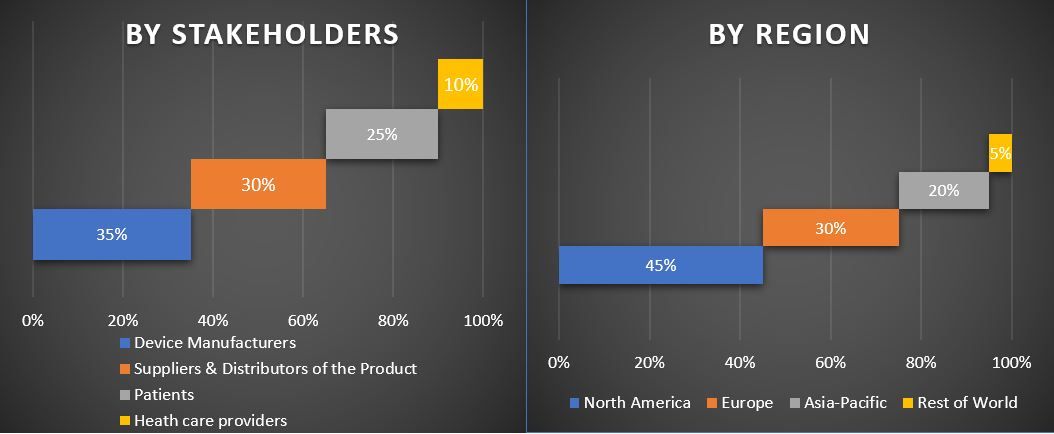- Home
- About Us
- Industry
- Services
- Reading
- Contact Us
Fetal Monitoring Market: Current Analysis and Forecast (2021-2027)
Emphasis on Product (Ultrasound Devices, Electronic Maternal/Fetal Monitors, Uterine Contraction Monitors, Fetal Electrodes, Fetal Doppler Devices, Accessories & Consumables, Others); Portability (Non-Portable Systems, Portable Systems); Method (Invasive, Non-invasive); Application (Antepartum, Intrapartum); End-User (Hospitals, Obstetrics & Gynecology Clinics, Home Care Settings); Region and Country

Fetal Monitoring Market was valued at US$ 3 billion in 2020 and is expected to grow at a CAGR of 6% over the forecast period (2021-2027). A diagnostic tool used to monitor the movement and heart rate of the fetus and maternal contractions is known as a fetal monitoring system. It is a fundamental device that is used for monitoring uterine contractions during labor. It mainly monitors well-being of the fetus and progress of labor. In medical terms, it is referred to as a medical method to check the health of an unborn baby to ensure a safe birth. In addition, it is also used to monitor chronic lung diseases, mental retardation, neonatal diseases, hypothermia, vision & hearing problems, and jaundice. During labor and in pregnancy, the doctor checks the heartbeat of the baby to monitor the health of the unborn fetus. It is a very common procedure adopted by healthcare providers during labor and pregnancy. There are two ways to do the monitoring. First is the external monitoring that requires a special tool called fetoscope that uses sound waves and computers. The second way of monitoring is internal monitoring that requires putting a small electrode on the baby’s head while he or she is in a female uterus.
The growth of this market is driven owing to the escalating prevalence of preterm births, favorable government policies, advanced technologies of fetal monitoring systems, and active product launches. For instance, according to World Health Organization, stated in 2018, approximately 15 million preterm babies are born each year (before 37 weeks of gestation), which is more than 1 out of 10 infants and this number is increasing per year. In 184 nations, preterm birth rates vary from 5% to 18% of infants born. Increase in preterm birth worldwide is one of the major factors in driving the market. Also, the development of noninvasive, portable, and advanced fetal monitors and emerging markets and strengthening infrastructure are anticipated to offer an opportunity for the growth of the market during the forecast period.
The 10 Countries With The Greatest Number Of Preterm Births, 2018
More than 60% of preterm births occur in Africa and South Asia, but preterm birth is truly a global problem. In the lower-income countries, on average, 12% of babies are born too early compared with 9% in higher-income countries. Within countries, poorer families are at higher risk. There is a dramatic difference in survival of premature babies depending on where they are born. For example, more than 90% of extremely preterm babies (less than 28 weeks) born in low-income countries die within the first few days of life; yet less than 10% of extremely preterm babies die in high-income settings.
Cardinal Health, Inc., Koninklijke Philips N.V., GE Healthcare, Siemens Healthineers, FUJIFILM SonoSite, Inc., Natus Medical Incorporated, Huntleigh Healthcare Limited, The Cooper Companies Inc., CONTEC Medical Systems Co., Ltd., EDAN Diagnostics, Inc. are some of the prominent players operating in the global fetal monitoring market. Several M&A’s along with partnerships have been undertaken by these players to develop new and advanced fetal monitoring products.
Insights Presented in the Report
“Amongst product, Ultrasound Devices segment holds the major share”
Based on product, the global fetal monitoring market is segmented into ultrasound devices, electronic maternal/fetal monitors, uterine contraction monitors, fetal electrodes, fetal doppler devices, accessories and consumables and others. Currently, ultrasound devices segment is expected to dominate the market by holding largest market share during the forecast period. Increasing congenital anomalies, maternal mortality, along with rising regulatory approvals are certain factors which are contributing to the growth of this segment.
“Amongst portability, Non-Portable Systems segment holds the major share”
By portability, the global Fetal Monitoring Market is segmented into non-portable systems and portable systems. Non-portable systems segment is dominating the market. Wide applications in hospitals and diagnostic centers to assess fetal and maternal health is the key factor responsible for the dominance of this segment in year 2020.
“Amongst method, the Noninvasive segment holds the major share”
In terms of method, the market is categorized into invasive and noninvasive. In 2020, the noninvasive segment held the largest market share in 2020 as these methods are widely accepted for their safer method of diagnosing and monitoring the fetus, especially in high-risk pregnancies. Additionally, rising approvals of various noninvasive monitoring devices coupled with coming advanced technologies are further anticipated to bolster the growth of this segment.
“Amongst application, the Antepartum segment holds the major share”
In terms of application, the market is bifurcated into antepartum and intrapartum. Among them, the antepartum segment is forecasted to lead the market share during the forecast period. This can be ascribed to the extensive monitoring regimes, recent product launches, surging prevalence of fetal anomalies, and maternal mortalities.
“Amongst end-user, the Hospitals segment holds the major share”
Based on end-user the market is categorized into hospitals, obstetrics & gynecology clinics, and home care settings. At present, hospital segment dominates the market and is expected to maintain its dominance during the analyzed period as well. This supremacy is ascribed can be attributed to several factors, such as highly advanced facilities in hospitals and the increasing number of pregnancy procedures
“North America signifies one of the largest markets of Fetal Monitoring Market”
For a better understanding of the market dynamics of the Fetal Monitoring market, a detailed analysis was conducted for different regions across the globe including North America (United States, Canada, and the Rest of North America), Europe (Germany, France, Italy, Spain, United Kingdom and Rest of Europe), Asia-Pacific (China, Japan, India, South Korea, and Rest of APAC), Rest of World has been conducted. North America dominated the market and generated revenue of USD XX million in 2020 which is attributable to the presence of a highly developed healthcare system, the increasing number of healthcare settings, technological advancements, rising patient awareness levels, and better reimbursement policies. At the same time, Asia-Pacific is anticipated to grow at the highest CAGR of XX% during the forecast period.
Reasons to buy this report:
- The study includes market sizing and forecasting analysis validated by authenticated key industry experts
- The report presents a quick review of overall industry performance at one glance
- The report covers an in-depth analysis of prominent industry peers with a primary focus on key business financials, product portfolio, expansion strategies, and recent developments
- Detailed examination of drivers, restraints, key trends, and opportunities prevailing in the industry
- The study comprehensively covers the market across different segments
- Deep dive regional level analysis of the industry
Customization Options:
The Fetal Monitoring market can further be customized as per the requirement or any other market segment. Besides this, UMI understands that you may have your own business needs, hence feel free to connect with us to get a report that completely suits your requirements.
Table of Content
Analyzing the historical market, estimation of the current market, and forecasting the future market of the Global Fetal Monitoring Market were the three major steps undertaken to create and analyze the adoption of Fetal Monitoring for the different diseases across major regions globally. Exhaustive secondary research was conducted to collect the historical market numbers and estimate the current market size. Secondly, to validate these insights, numerous findings and assumptions were taken into consideration. Moreover, exhaustive primary interviews were also conducted, with industry experts across the value chain of Fetal Monitoring. Post assumption and validation of market numbers through primary interviews, we employed a top-down approach to forecast the complete market size. Thereafter, market breakdown and data triangulation methods were adopted to estimate and analyze the market size of segments and sub-segments the industry pertains to. Detailed methodology is explained below:
Analysis of Historical Market Size
Step 1: In-Depth Study of Secondary Sources:
Detailed secondary study was conducted to obtain the historical market size of the Fetal Monitoring market through company internal sources such as annual report & financial statements, performance presentations, press releases, etc., and external sources including journals, news & articles, government publications, competitor publications, sector reports, third-party database, and other credible publications.
Step 2: Market Segmentation:
After obtaining the historical market size of the Fetal Monitoring market, we conducted a detailed secondary analysis to gather historical market insights and share for different segments for major regions. Major segments included in the report are product and end-user. Further country-level analyses were conducted to evaluate the overall utilization of Fetal Monitoring in every region.
Step 3: Factor Analysis:
After acquiring the historical market size of different segments and sub-segments, we conducted a detailed factor analysis to estimate the current market size of Fetal Monitoring market. Further, we conducted factor analysis using dependent and independent variables such as increasing number of preterm and low-weight births. A thorough analysis was conducted for demand and supply-side scenario considering top partnerships, merger and acquisition, business expansion, and product launches in the Fetal Monitoring industry across the globe.
Current Market Size Estimate & Forecast
Current Market Sizing: Based on actionable insights from the above 3 steps, we arrived at the current market size, key players in the Fetal Monitoring market, and market shares of the segments. All the required percentage shares split, and market breakdowns were determined using the above-mentioned secondary approach and were verified through primary interviews.
Estimation & Forecasting: For market estimation and forecast, weights were assigned to different factors including drivers & trends, restraints, and opportunities available for the stakeholders. After analyzing these factors, relevant forecasting techniques i.e. top-down/bottom-up approach was applied to arrive at the market forecast about 2027 for different segments and subsegments across the major markets globally. The research methodology adopted to estimate the market size encompasses:
- The industry’s market size, in terms of value (USD) and the utilization rate of Fetal Monitoring across the major markets domestically
- All percentage shares, splits, and breakdowns of market segments and sub-segments
- Key players in the Fetal Monitoring market in terms of services offered. Also, the growth strategies adopted by these players to compete in the fast-growing market
Market Size and Share Validation
Primary Research: In-depth interviews were conducted with the Key Opinion Leaders (KOLs) including Top Level Executives (CXO/VPs, Sales Head, Marketing Head, Operational Head, and Regional Head, Country Head, etc.) across major regions. Primary research findings were then summarized, and statistical analysis was performed to prove the stated hypothesis. Inputs from primary research were consolidated with secondary findings, hence turning information into actionable insights.
Split of Primary Participants in Different Regions
Market Engineering
Data triangulation technique was employed to complete the overall market estimation and to arrive at precise statistical numbers of each segment and sub-segment of the Fetal Monitoring market. Data was split into several segments & sub-segments post studying various parameters and trends in the areas of product, portability, method, application, end user of the Fetal Monitoring market.
Main Objective of the Fetal Monitoring Market Study
The current & future market trends of Fetal Monitoring were pinpointed in the study. Investors can gain strategic insights to base their discretion for investments from the qualitative and quantitative analysis performed in the study. Current and future market trends were determined the overall attractiveness of the market at a regional level, providing a platform for the industrial participant to exploit the untapped market to benefit as a first-mover advantage. Other quantitative goals of the studies include:
- Analyze the current and forecast market size of Fetal Monitoring in terms of value (USD). Also, analyze the current and forecast market size of different segments and sub-segments
- Segments in the study include areas of product, portability, method, application, end user
- Define and analysis of the regulatory framework for the Fetal Monitoring industry
- Analyze the value chain involved with the presence of various intermediaries, along with analyzing customer and competitor behaviors of the industry
- Analyze the current and forecast market size of the Fetal Monitoring market for the major region
- Major regions studied in the report include North America (United States, Canada, and the Rest of North America), Europe (Germany, France, Italy, Spain, United Kingdom and Rest of Europe), Asia-Pacific (China, Japan, India, South Korea, and Rest of APAC), and Rest of the World
- Company profiles of the Fetal Monitoring market and the growth strategies adopted by the market players to sustain in the fast-growing market
- Deep dive regional level analysis of the industry
Related Reports
Customers who bought this item also bought












